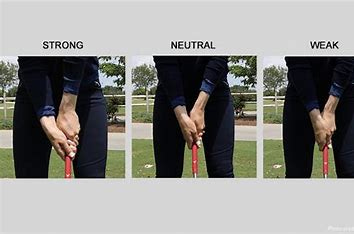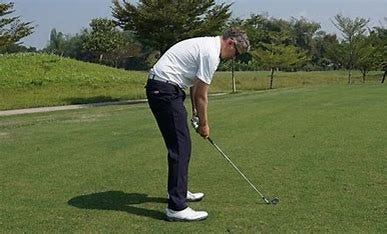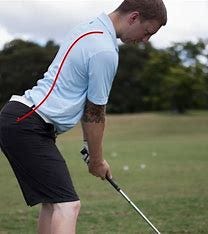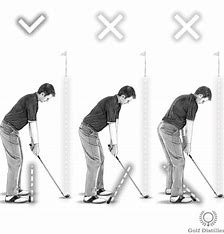I watch golfers on the driving range working on the takeaway or shallowing the club or club position at the top of the backswing or all kinds of swing positions they believe will help them become better players. But most of them would benefit much more if they focused on grip, posture, alignment, ball position, face control and ball-ground contact (low point control). While this seems obvious, few golfers work on these.
Grip
Your hands are the only physical connection to the golf club. The hands control the clubface and must work as a unit. They cannot work against each other. There are three basic hand positions: weak, neutral and strong. In the past, a weak hand position was taught almost exclusively with a strong hand position largely frowned upon, but today many coaches are teaching as strong a hand position as possible. A weak grip tends to promote a slice while a strong grip tends to promote a hook.
Notice in each position there is a “V” formed between the thumb and forefinger of each hand. The “V’s” should point in the same direction with parallel lines formed.
Aside from hand position, there are three different grips a player can employ: ten-finger, interlock and overlap. The ten-finger or “baseball” grip is the least used with the interlock and overlap the most popular. Players with smaller hands tend to use the interlock or ten-finger grip. Players with larger hands tend to prefer the overlap grip.
Additionally, the grip should be in the fingers and not in the palm.
Posture
Correct posture aids in allowing the club to swing on plane properly. Poor posture will cause numerous problems with the swing. The two most common forms of poor posture are “C” and “S” posture.
C posture is an excessive rounding of the shoulder. C posture reduces the ability to rotate the upper body causing the swing to rely too much on the arms.
S posture is an excessive arching of the lower back. This puts a tremendous amount of stress on the lower back. It also causes problems with the ability to turn.
Ideally, the back should be flat. This enables the body to turn properly.
Alignment
Many golfers struggle with direction and shape of shots because of poor alignment. Feet, hips and shoulders all need to be aligned parallel to the target line. Too often at least one of these is misaligned.
Setting up with an open or closed alignment affects swing path and plane. If you struggle with a slice or hook, make sure your alignment is correct.
Setup alignment sticks on the practice tee to help create proper alignment.
Ball Position
This is the easiest fundamental to check and is rarely correct. I cringe when I see a driver with a ball position almost in the center of the stance. There is no chance to consistently hit good tee shots.
This is a basic chart for ball position. Driver needs to be off the lead heel. Slower swing speed players can even place the ball off the lead toe. As the clubs get shorter, the ball position moves gradually back towards the center of the stance. These positions allow the golf clubs to perform as they are designed. For example, the driver is designed to strike the ball on a level or upward angle of attack. Irons are designed to strike the ball on a downward angle of attack.
While this all seems like I’m being Captain Obvious, I rarely see players working on these basics. Tour players always start with the basics when they are struggling because, more often than not, one of these is off and causing issues with the swing.
If you want to learn about face control and ball-ground contact (low point control)
As always, be thankful when you get to play this amazing game. Be grateful for every shot. Appreciate every moment on the course. Now, go golf!
Next week I will be on my annual golf trip to Toftrees. I will be sending out one of my previous newsletters. Have a great week everyone!
Keep reading with a 7-day free trial
Subscribe to Go Golf to keep reading this post and get 7 days of free access to the full post archives.










